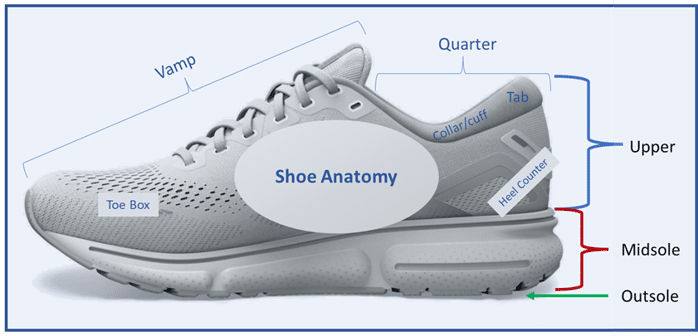Step Ahead: How Injury Prevention Starts with Your Shoes
As we enter the spring, a season of rebirth and renewal and a time for cleaning and growth, many of us head to the great outdoors to enjoy activities that were impossible, difficult, or unpleasant during the cold and snowy months. One of these activities is running.
Running offers an excellent cardiovascular workout that helps keep our hearts and lungs healthy. However, it’s not without its risks. As our bodies age, wear and tear—particularly from impact, weight gain, and poor biomechanics—can lead to frequent injuries, chronic pain, and even arthritis. The use of old or improper equipment can also contribute to injury.
Running shoes and athletic footwear have undergone remarkable changes over the past 30 to 40 years. Modern designs now feature improved lasts, advanced cushioning, and energy-storing materials, all aimed at increasing speed, performance, and protection.
How Long Do Running Shoes Last?
Running shoes typically last between 300 and 500 miles. This lifespan is influenced by factors like the runner’s weight, stride, terrain, and the type of shoe. The midsole cushioning, which absorbs impact, is the first to degrade.
Running Shoe Anatomy
Knowing the components and their purpose is key to help you better understand running shoes.
A shoe is Broken down into 3 main sections: the Upper, the Midsole, and the Outsole.
- Upper: The outer layer, providing support, breathability, and comfort.
- Midsole: The cushioning layer between the upper and outsole, absorbing impact.
- Outsole: The rubber sole, providing traction and durability.
What Factors Affect the Lifespan of Running Shoes?
- Running Frequency and Mileage: More frequent running will wear down shoes faster.
- Runner’s Weight: Heavier runners will experience more impact and wear on their shoes.
- Stride and Gait: The way a runner lands and moves their foot can affect where and how quickly a shoe wears out.
- Terrain: Running on hard or uneven surfaces can accelerate wear.
- Weather: Wet or humid conditions can damage shoe materials.
- Type of Shoe: Race shoes are generally lighter and less durable than training shoes.
Signs It's Time to Replace Shoes
- Reduced Cushioning: The midsole feels less soft and responsive.
- Excessive Wear on the Outsole: The rubber sole shows significant wear or is worn unevenly.
- New Aches and Pains: Experiencing injuries or pains without changes in training volume.
- Loose Upper Stitching: The upper materials are fraying or coming loose.
Orthopedic Conditions Linked to Improper Footwear
-
Plantar Fasciitis: One of the most common causes of heel pain, often aggravated by poor arch support or shoes with inadequate cushioning.
-
Achilles Tendinitis: Tight or unsupportive shoes can strain the Achilles tendon, especially in runners.
-
Shin Splints: Often related to overuse, but shoes lacking proper shock absorption can contribute significantly.
-
Stress Fractures: Repeated impact without proper footwear support can lead to small fractures, especially in the feet and lower legs.
-
Runner’s Knee: Caused by poor alignment, often exacerbated by shoes that don’t support your natural gait.
-
Flatfoot: Wearing shoes without sufficient arch support can worsen structural foot problems over time.
-
Ankle Instability or Sprains: Shoes without adequate heel counter support can contribute to rolling or twisting of the ankle.
Tips to Extend Shoe Lifespan
- Rotate Shoes: Use multiple pairs to distribute wear.
- Keep Shoes Clean: Regularly clean your shoes to remove debris that can damage materials.
- Store Properly: Avoid storing shoes in direct sunlight or heat.
- Avoid Non-Running Activities: Wear them only for running to minimize wear
What Type of Shoe is Best?
When it comes to the question, “What type of shoe is best?” there’s no single brand or style that works for everyone. The real answer is: the best shoe is the one that offers the right combination of features for your individual needs. Some people claim that certain types of shoes lead to more injuries, but emerging research shows it’s not that one shoe causes more injuries overall. It is that different types of shoes may predispose you to different kinds of injury patterns.
If you’re experiencing foot or ankle pain and suspect your footwear may be part of the problem, our foot and ankle specialists can help evaluate your needs and guide you toward the right support.
Meet Dr. Aron Green
Dr. Green, a Northern New Jersey native, completed his medical degree at UMDNJ – New Jersey Medical School before training in orthopedic surgery at Monmouth Medical Center and specializing in foot and ankle care at AGH in Pittsburgh. With over 10 years of experience in minimally invasive bunion surgery, he offers advanced techniques for faster recovery, improved mobility, and reduced scarring.



